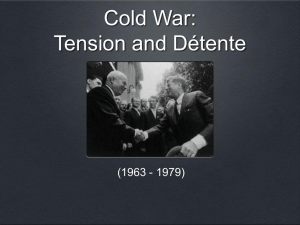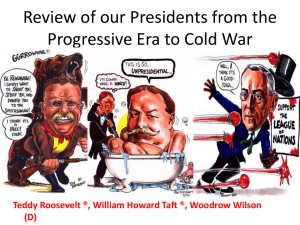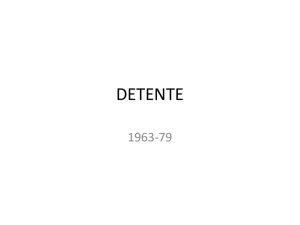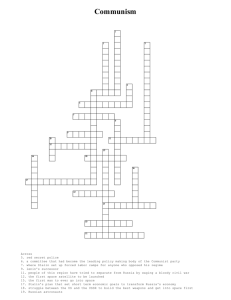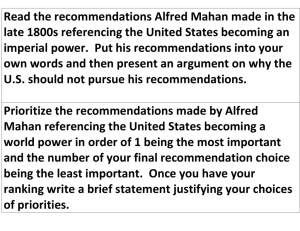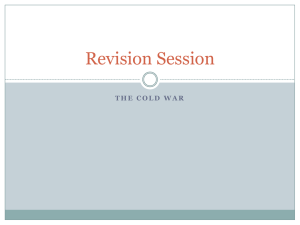Was the Cuban Missile Crisis a turning point in US
advertisement
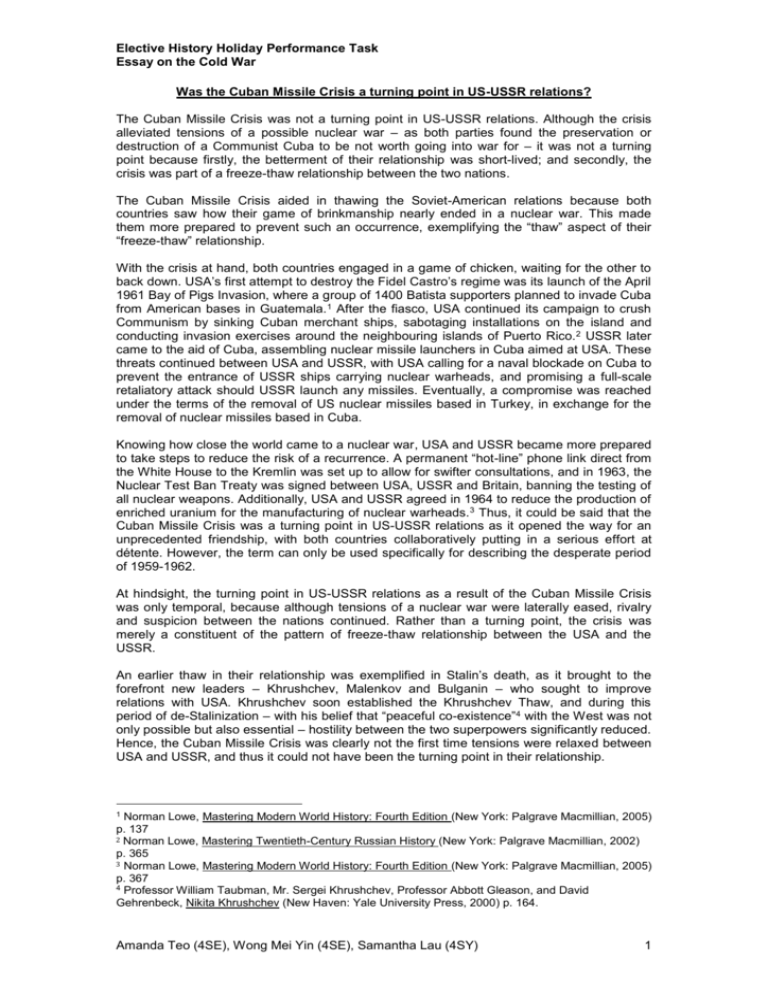
Elective History Holiday Performance Task Essay on the Cold War Was the Cuban Missile Crisis a turning point in US-USSR relations? The Cuban Missile Crisis was not a turning point in US-USSR relations. Although the crisis alleviated tensions of a possible nuclear war – as both parties found the preservation or destruction of a Communist Cuba to be not worth going into war for – it was not a turning point because firstly, the betterment of their relationship was short-lived; and secondly, the crisis was part of a freeze-thaw relationship between the two nations. The Cuban Missile Crisis aided in thawing the Soviet-American relations because both countries saw how their game of brinkmanship nearly ended in a nuclear war. This made them more prepared to prevent such an occurrence, exemplifying the “thaw” aspect of their “freeze-thaw” relationship. With the crisis at hand, both countries engaged in a game of chicken, waiting for the other to back down. USA’s first attempt to destroy the Fidel Castro’s regime was its launch of the April 1961 Bay of Pigs Invasion, where a group of 1400 Batista supporters planned to invade Cuba from American bases in Guatemala. 1 After the fiasco, USA continued its campaign to crush Communism by sinking Cuban merchant ships, sabotaging installations on the island and conducting invasion exercises around the neighbouring islands of Puerto Rico. 2 USSR later came to the aid of Cuba, assembling nuclear missile launchers in Cuba aimed at USA. These threats continued between USA and USSR, with USA calling for a naval blockade on Cuba to prevent the entrance of USSR ships carrying nuclear warheads, and promising a full-scale retaliatory attack should USSR launch any missiles. Eventually, a compromise was reached under the terms of the removal of US nuclear missiles based in Turkey, in exchange for the removal of nuclear missiles based in Cuba. Knowing how close the world came to a nuclear war, USA and USSR became more prepared to take steps to reduce the risk of a recurrence. A permanent “hot-line” phone link direct from the White House to the Kremlin was set up to allow for swifter consultations, and in 1963, the Nuclear Test Ban Treaty was signed between USA, USSR and Britain, banning the testing of all nuclear weapons. Additionally, USA and USSR agreed in 1964 to reduce the production of enriched uranium for the manufacturing of nuclear warheads. 3 Thus, it could be said that the Cuban Missile Crisis was a turning point in US-USSR relations as it opened the way for an unprecedented friendship, with both countries collaboratively putting in a serious effort at détente. However, the term can only be used specifically for describing the desperate period of 1959-1962. At hindsight, the turning point in US-USSR relations as a result of the Cuban Missile Crisis was only temporal, because although tensions of a nuclear war were laterally eased, rivalry and suspicion between the nations continued. Rather than a turning point, the crisis was merely a constituent of the pattern of freeze-thaw relationship between the USA and the USSR. An earlier thaw in their relationship was exemplified in Stalin’s death, as it brought to the forefront new leaders – Khrushchev, Malenkov and Bulganin – who sought to improve relations with USA. Khrushchev soon established the Khrushchev Thaw, and during this period of de-Stalinization – with his belief that “peaceful co-existence”4 with the West was not only possible but also essential – hostility between the two superpowers significantly reduced. Hence, the Cuban Missile Crisis was clearly not the first time tensions were relaxed between USA and USSR, and thus it could not have been the turning point in their relationship. 1 Norman Lowe, Mastering Modern World History: Fourth Edition (New York: Palgrave Macmillian, 2005) p. 137 2 Norman Lowe, Mastering Twentieth-Century Russian History (New York: Palgrave Macmillian, 2002) p. 365 3 Norman Lowe, Mastering Modern World History: Fourth Edition (New York: Palgrave Macmillian, 2005) p. 367 4 Professor William Taubman, Mr. Sergei Khrushchev, Professor Abbott Gleason, and David Gehrenbeck, Nikita Khrushchev (New Haven: Yale University Press, 2000) p. 164. Amanda Teo (4SE), Wong Mei Yin (4SE), Samantha Lau (4SY) 1 Elective History Holiday Performance Task Essay on the Cold War Moreover, the crisis could not have been a turning point, as the thaw did not last with the continuation of rivalry and disagreement. A point of post-crisis conflict would be USA’s war against Communist Vietnam (1961-1973), in which USSR provided Vietnam with monetary and military aid. In addition, a nuclear arms race started with USSR determined to catch up with USA in their nuclear arms stockpile of inter-continental ballistic missiles (ICBMs) and submarine-launched ballistic missiles (SLBMs), to increase their own security and be somewhere on par with USA to persuade them to limit and reduce their arms build-up. The response of USA was to invent even more terrifying weapons like the multiple independently targetable reentry vehicle (MIRV), which only spurred USSR to create its own version known as the SS-20 (1977)5. With this, USA and USSR engaged in a stiff competition to constantly better each other in nuclear warfare supremacy, putting an end to all efforts of détente with both superpowers able to destroy each other many times over. In conclusion, the Cuban Missile Crisis was not a turning point in US-USSR relations, but simply part of their freeze-thaw relationship. However, we must recognize that it did warm their icy tensions – as both parties realised what was in their country’s best interests and in the interests of mankind, hence understanding the imperative of swift consultation and the dangers of adopting the concept of brinkmanship. Nevertheless, we maintain that the crisis was not a turning point as this was not the only time tensions between the two superpowers eased. Stalin’s death also led to a temporal period of peaceful co-existence between East and West. Furthermore, the after-events of the crisis did not show sustained friendliness, as USA and USSR engaged in a tight nuclear arms race. Thus, the Cuban Missile Crisis could not be a turning point in the two countries’ relations. (892 Words) Bibliography 1. About.com, http://usforeignpolicy.about.com/od/countryprofile1/p/usrussia.htm, (accessed 10 December 2009) 2. Lowe, N. (2008) Mastering Modern World History (Fourth Edition). New York: Palgrave Macmillian, pp.137 3. Lowe, N. (2002) Mastering Twentieth-Century Russian History. New York: Palgrave Macmillan, pp.316-320, 361-367, 389-391 4. Taubman, W. Khrushchev, S. Gleason, A. Gehrenbeck, D. (2000) Nikita Khrushchev. New Haven: Yale University Press, pp.164 5. Thomson, J.R. (1977) U.S. /U.S.S.R. strategic forces, asymmetrical developments: a net American assessment. Lanham: University Press of America pp.131 6. U.S. Department of State, http://state.gov/r/pa/ho/pubs/fs/46345.htm, (accessed 12 December 2009) 7. Wikipedia, http://en.wikipedia.org/wiki/Nuclear_arms_race, (accessed 16 December 2009) 5 Jeffrey R. Thomson, U.S. /U.S.S.R. strategic forces, asymmetrical developments: a net American assessment (Lanham: University Press of America, 1977) p. 131. Amanda Teo (4SE), Wong Mei Yin (4SE), Samantha Lau (4SY) 2
